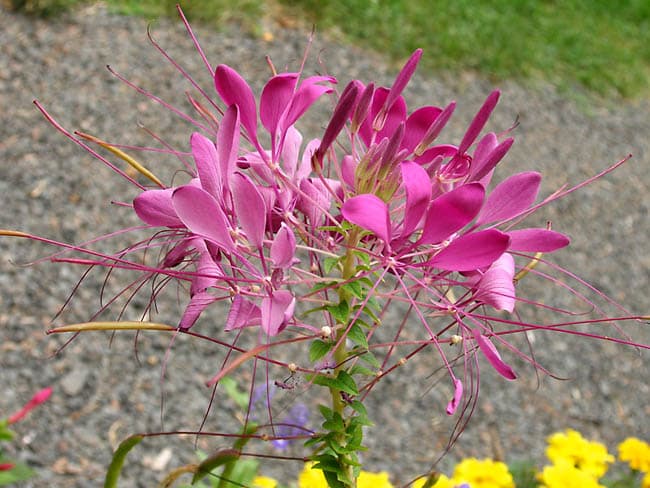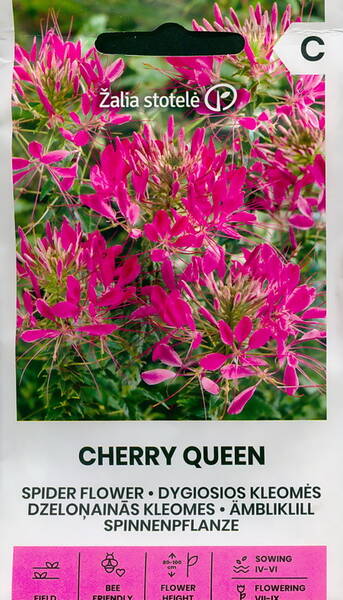Bright cherry-red tassels!
A herbaceous plant with erect stems, 40-60 cm tall. The cherry-colored flowers have an original shape, are four-petaled, 2-3 cm in diameter, on long pedicels, and are collected in apical racemose inflorescences. Blooms profusely from July to September.
Used in mixborders, group and single plantings.
1.0 g = 300-400 seeds.
Due to the unique shape of its inflorescences, Germans call the cleome flower "spinenpflanze", which means "spider plant". The unusual racemes look like an explosion, a burst of champagne – you might not like this plant, but it's impossible not to notice it: the spectacular beauty of the flowers, the strange scent, and the fact that cleome blooms all summer (from June to September) – these qualities are simply super attractive!

Cleome propagates exclusively by seeds, which can be sown directly in the ground in spring or before winter (in November-December), but it is best to use the seedling method.
Before sowing, cleome seeds are soaked for 12 hours in a solution of "Zircon" or "Epin" (1 drop of the preparation per half glass of warm boiled water) to speed up the germination process, then sown in a shallow container with seedling soil (garden soil mix, humus, and sand in a 2:2:1 ratio), sprinkled on top with a 1.5 cm layer of the same soil, and covered with glass to create a greenhouse effect.
Cleome germinates from seeds slowly (after 2-3 weeks). After emergence, the seedlings are immediately moved to a bright windowsill and given additional light in the evenings. The soil is moistened as needed – not often, but abundantly, allowing the soil to dry out between waterings. To prevent root diseases, water the seedlings once with a weak solution of potassium permanganate.
When the seedlings have a pair of true leaves, they are pricked out into peat-humus pots, buried in the soil up to the cotyledon leaves. Two weeks after pricking out, the seedlings can be fed with a complex mineral fertilizer in a weak concentration, and then fertilized every two weeks. Turn the pots occasionally relative to the light source so the seedlings don't grow lopsided...
When the spring return frosts have passed, you can safely plant the seedlings in the ground (this time usually comes in late May or early June).
Choose a sunny area without strong drafts for cleome seedlings: they need nothing more, although in fertile, neutral soil with good moisture, cleome grows better than in poor, dry soil. Therefore, if the soil in the area for cleome leaves much to be desired, add a bucket of well-rotted compost and two tablespoons of granular flower fertilizer per 1 m2 when digging.
Before planting the seedlings for better rooting in open ground, spray them with a solution of the stimulant "Epin-extra" with a microfertilizer (for example, Cytovit).
Planting cleome in open ground is done with the peat-humus pots, at a distance of 50 to 70 cm between plants. This is done so that the planting does not become too dense, and the plants are not affected by pests and diseases, stimulating abundant and bright flowering.
After planting, water the cleome at the root with a solution of humate.
Further care is quite simple: water only in hot weather (infrequently but abundantly), feed every two weeks at the root with complex fertilizers for flowers, diluting two tablespoons of fertilizer in 10 liters of water. A weak and sick cleome bush should be fed by foliar spraying with a solution of one teaspoon of fertilizer in 3 liters of water. If you really want to see cleome bloom earlier, spray it before the buds begin to form with a solution of "Zircon" at the rate of 1 ml/1 liter of water.
In addition to these manipulations, growing cleome involves weeding and loosening the soil if you were too lazy to mulch it after planting.
Pests and diseases.
"Thanks" to its scent, which is far from floral, insect pests do not approach the plant.
And cleome gets sick very rarely: only if you planted it close to groundwater or watered it excessively, so we can consider cleome invulnerable!
Only two species of the plant have been introduced into cultivation so far – Cleome hassleriana and Cleome spinosa (Spiny Cleome). These two tropical South American species are very similar, differing only in flower color, so for convenience, florists commonly call both species Cleome spinosa.
These species are also used to create new varieties and hybrids through crossing.
The most popular varieties of Cleome spinosa.
The most sought-after is the Cleome spinosa variety "Cherry Queen", up to 60 cm tall, with fragrant flowers 2-3 cm in diameter, of original shape, on long pedicels.
As for Cleome hassleriana, the variety "Champagne Splash" bred from this species is grown in cultivation. The variety's height is 120 cm, white or pink flowers 3-4 cm in diameter are collected in a raceme inflorescence up to 20 cm in diameter. Blooms from July until frost.
Used as a solo plant and in groups with annuals such as Lavatera or flowering tobacco. Quite often, cleome (due to its height) is grown as a background for a flower bed or as a hedge.
Cut cleome inflorescences last in water for more than 10 days, so they can be used for original floral arrangements.
Eng.: Cleome, Spiny spiderflower, Spider Flower, Spider Legs, Grandfathers Whiskers. Bot. syn.: Cleome sandwicensis Gray, Neocleome spinosa (Jacq.) Small.












